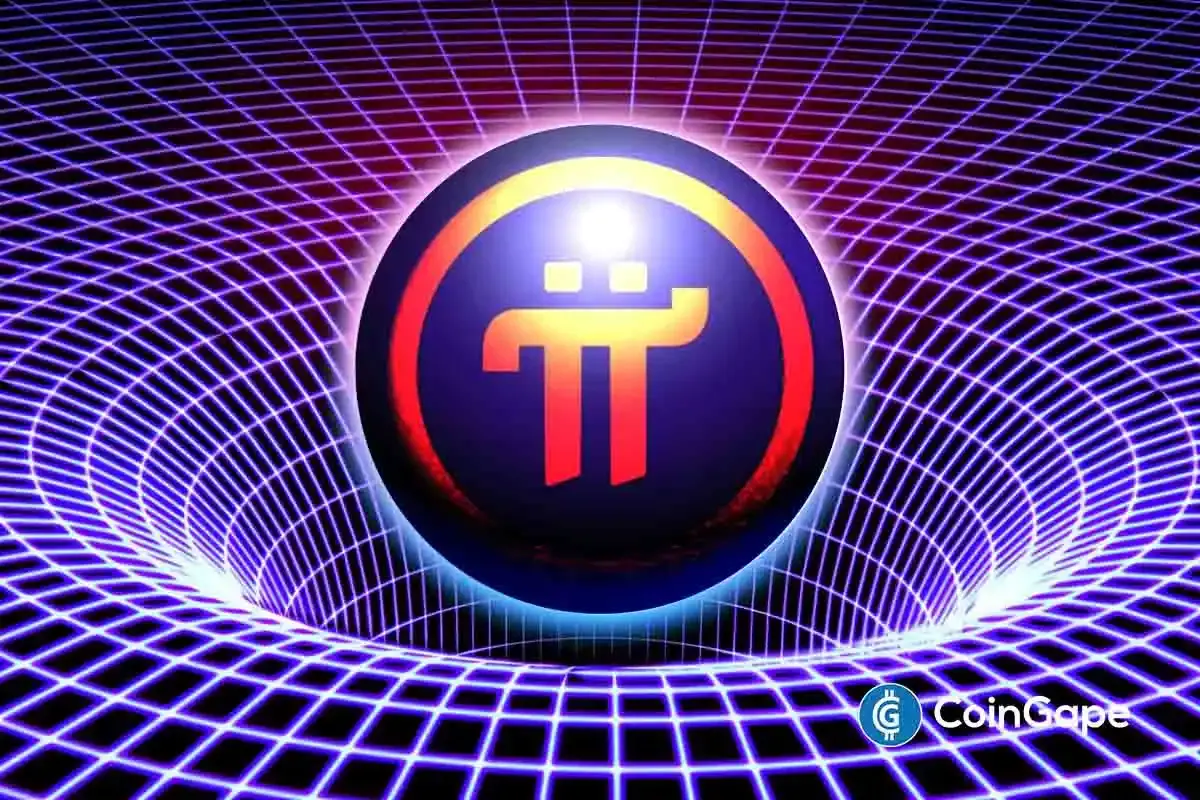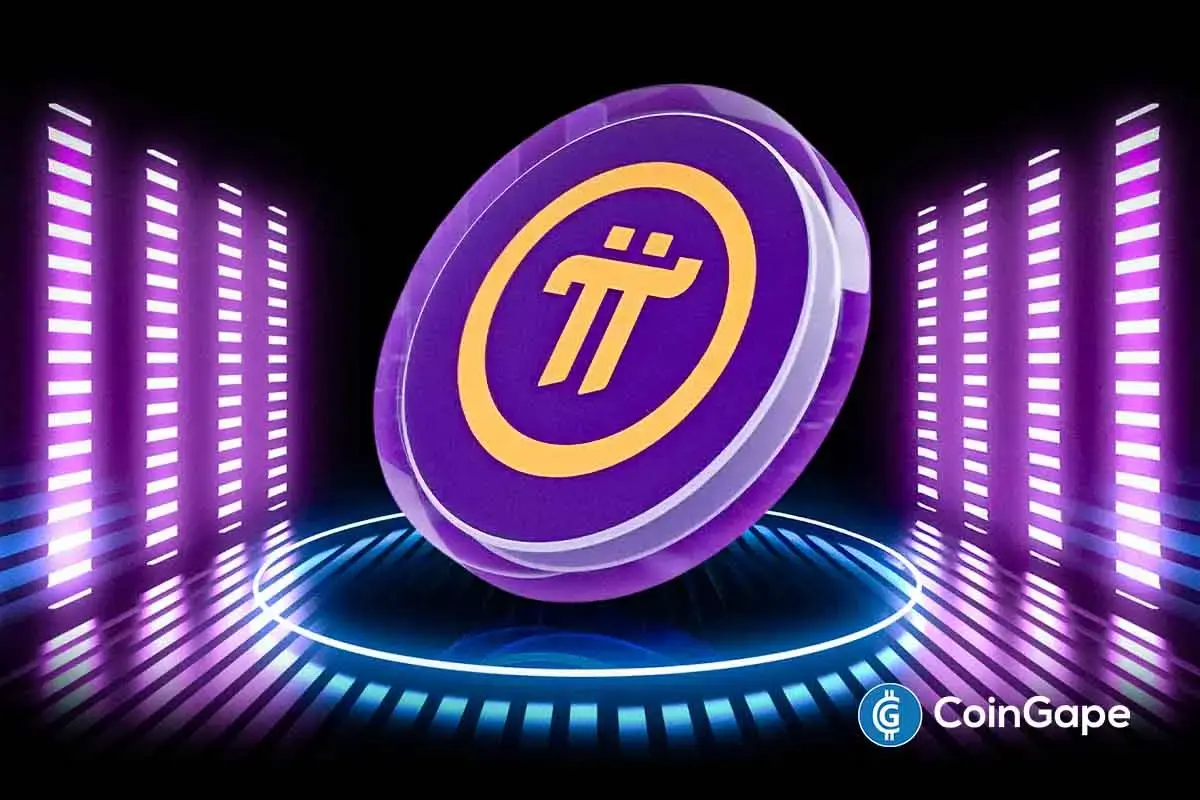Market
Bittensor (TAO) Futures Traders Bet Against Rally: Price Impact

TAO, the altcoin that powers Bittensor’s decentralized machine learning network, has witnessed a 36% price rally in the past 24 hours as the general cryptocurrency market rebounds following Monday’s decline.
This has led to an uptick in the token’s derivatives market activity. However, this is not without a catch.
Bittensor Futures Traders Bet Against a Price Rally
According to Coinglass, TAO’s derivatives market has recorded a 14% upswing in daily trading volume in the past 24 hours.
When an asset sees an increase in derivatives trading volume, it suggests a growing interest in the underlying asset. Since derivatives allow traders to speculate on price movements without owning the underlying asset, a spike in trading volume may suggest that more traders are engaging in speculative activities, which may drive up price volatility.
TAO’s rising open interest confirms this influx of new traders over the past 24 hours. According to Coinglass, the coin’s open interest has increased by 32% during that period, totaling $38.31 million.
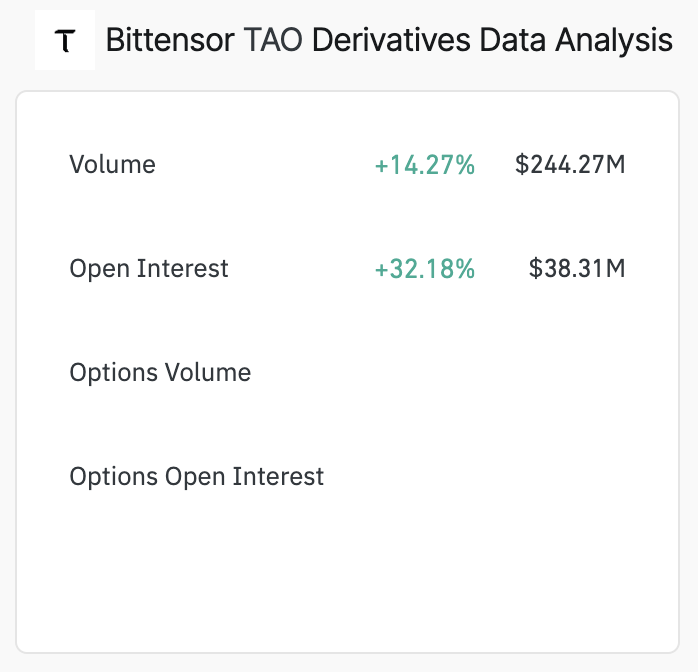
Read More: Top 9 Safest Crypto Exchanges in 2024
An asset’s open interest refers to the total number of outstanding derivative contracts, such as options or futures, that have not been settled. When it spikes like this, more traders are opening new positions in the market.
However, TAO’s negative funding rate signals that these new traders have mostly opened short positions. As of this writing, the token’s funding rate across cryptocurrency exchanges is -0.01%.

Funding rates are used in perpetual futures contracts to ensure an asset’s contract price stays close to its spot price. When they are negative, it means more traders are buying the asset, expecting a decline, than those buying in anticipation of a rally.
TAO Price Prediction: A Bullish Divergence Offers Hope
Readings from TAO’s one-day chart reveal that its double-digit price rally over the past 24 hours might not be sustainable. This is because the bearish bias toward the altcoin is still significant.
At press time, its Elder-Ray Index returns a negative value of -64.2. For context, this indicator has returned values below zero since July 30, and the recent price rally has not changed that.
An asset’s Elder-Ray Index measures the relationship between the strength of buyers and sellers in the market. When its value is negative, it means that bear power outweighs bullish presence.
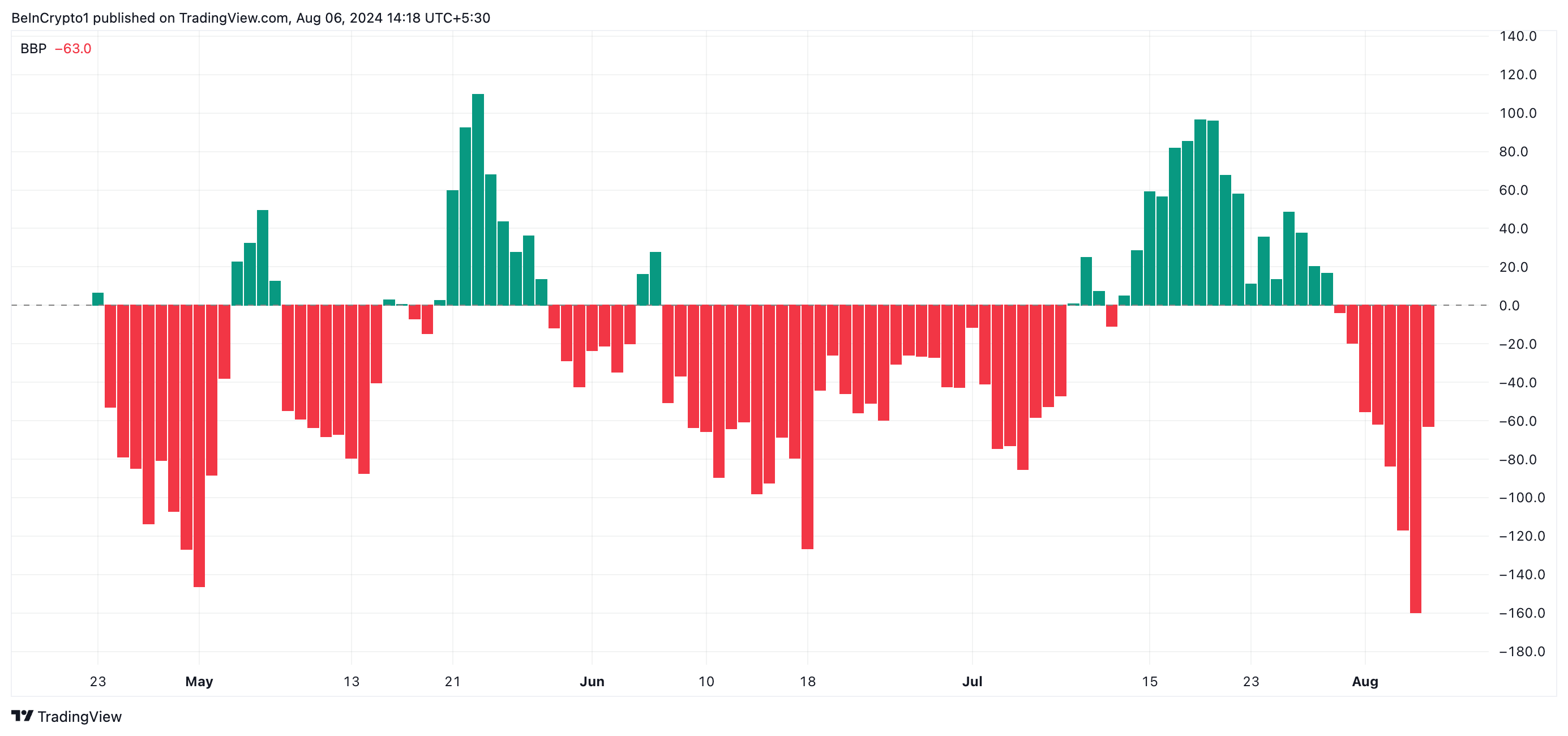
If the bears remain in control and continue to put downward pressure on TAO, its price may fall below $200 to trade at $163.70.
However, the bullish divergence between TAO’s price and its Chaikin Money Flow (CMF) hints at the possibility of a rally. While TAO’s price has maintained a downtrend since July 28, its CMF has risen, creating a bullish divergence.
This divergence often signals a potential bullish reversal. While the price is declining, buying pressure is increasing, which could lead to a price uptrend.
Read More: How To Invest in Artificial Intelligence (AI) Cryptocurrencies?
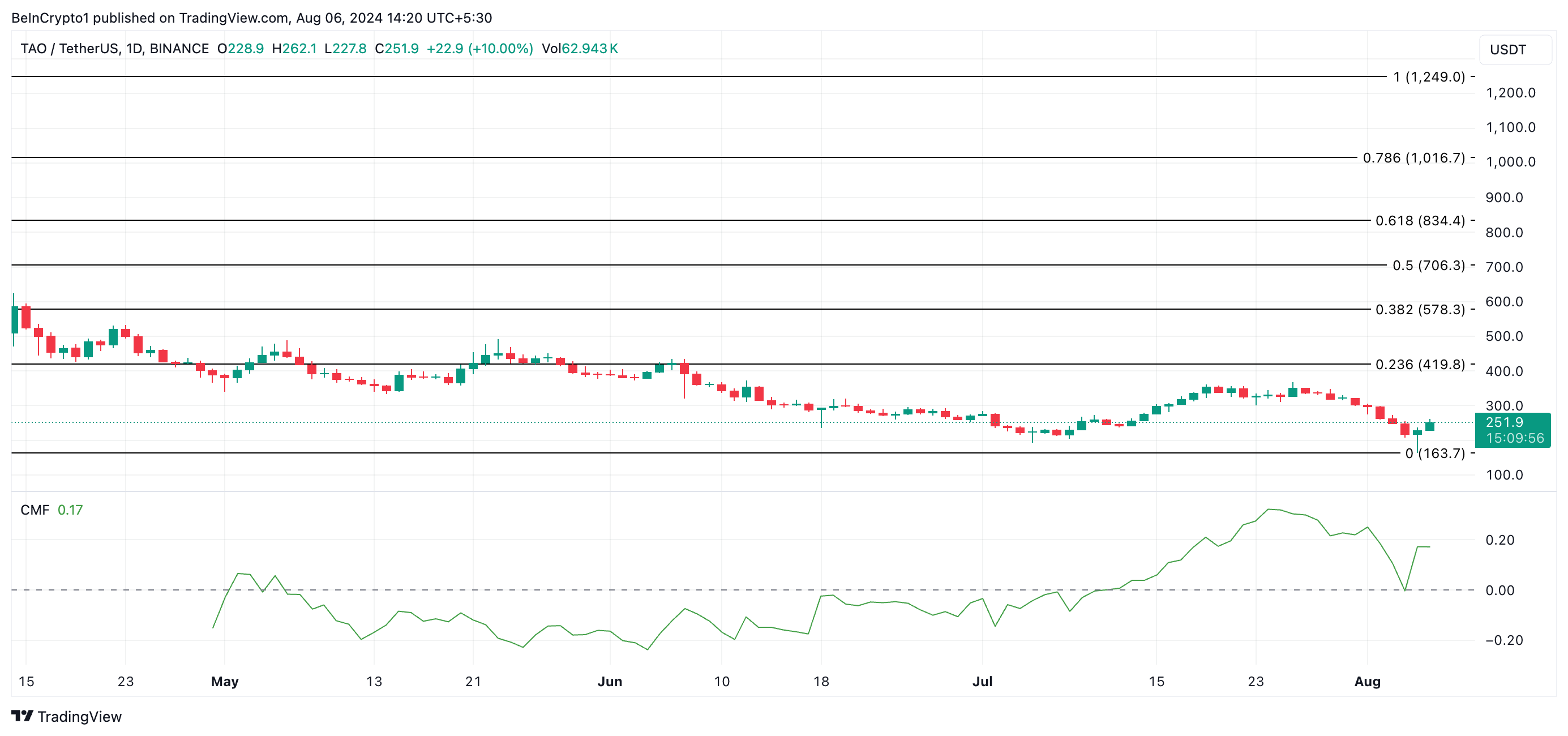
If this buying pressure gains momentum, it could push the token’s value to a two-month high of $419.80.
Disclaimer
In line with the Trust Project guidelines, this price analysis article is for informational purposes only and should not be considered financial or investment advice. BeInCrypto is committed to accurate, unbiased reporting, but market conditions are subject to change without notice. Always conduct your own research and consult with a professional before making any financial decisions. Please note that our Terms and Conditions, Privacy Policy, and Disclaimers have been updated.
Market
SEC’s Guidance Raises Questions About Tether’s USDT
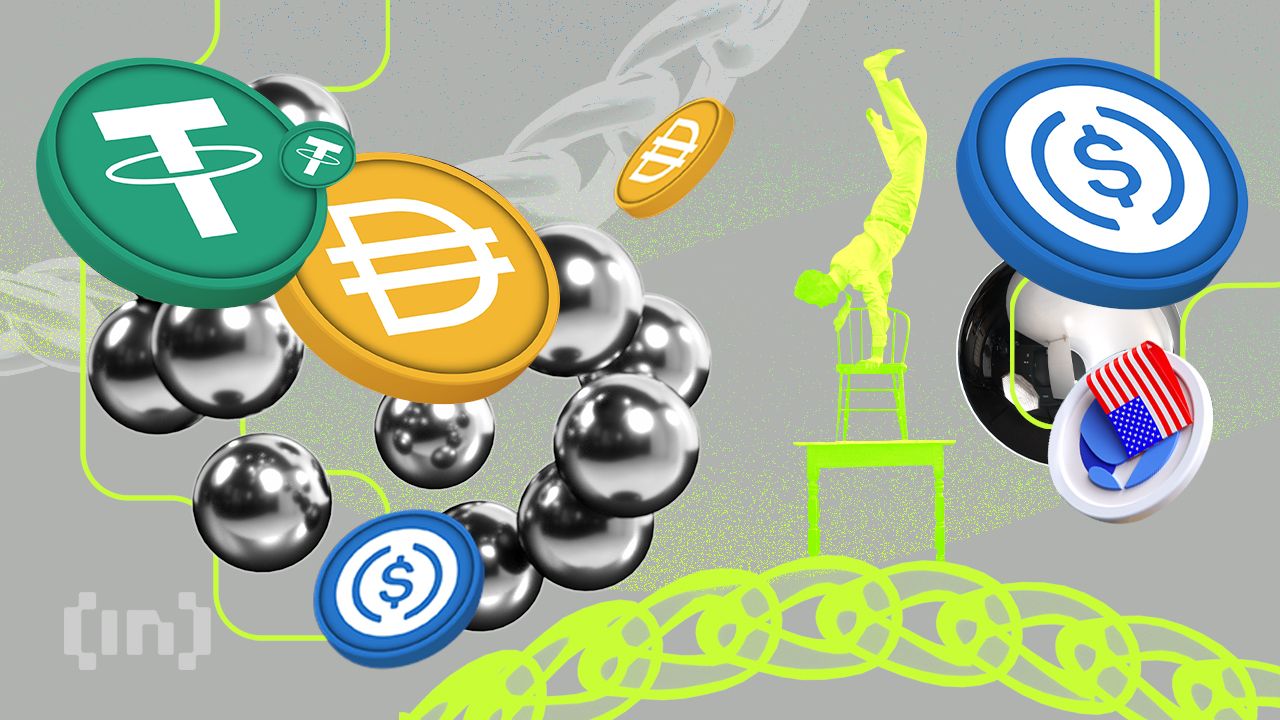
The US Securities and Exchange Commission (SEC) has issued one of its most definitive statements yet on the regulatory treatment of stablecoins.
In a move that could reshape the market, the agency clarified that certain stablecoins, under specific conditions, do not fall under the definition of securities.
Tether Considers Shifting Strategy with SEC’s New Update
The SEC labeled these assets as “covered stablecoins,” and they must meet strict requirements to remain outside the regulator’s oversight.
“Covered Stablecoins are not marketed as investments; rather, they are marketed as a stable, quick, reliable and accessible means of transferring value, or storing value and not for potential profit or as investments,” the SEC explained.
According to the statement, a covered stablecoin must maintain a one-to-one peg with the US dollar and be backed by highly liquid, low-risk assets.
It must also be redeemable on demand at full value. Importantly, these tokens cannot offer profit, interest, governance rights, or ownership stakes. Their sole function must be payment, money transfer, or value storage.
The SEC explained that these assets are not investment vehicles and are typically marketed as “digital dollars.” As such, the agency does not consider its offer or sale to involve securities under federal law.
“Accordingly, it is the Division’s view that Covered Stablecoins are not offered or sold as investment contracts,” the financial regulator concluded.
This marks a rare moment of clarity from the SEC, which has often taken an ambiguous or enforcement-first approach to crypto regulation.
However, while the SEC’s guidance clearly provides a path forward for stablecoins like USDC, it casts doubt on whether Tether’s USDT qualifies. The guidance specifically excludes reserves made up of crypto assets or precious metals, both of which are part of USDT’s current backing.

Meanwhile, Forbes journalist Nina Bambysheva reported that Tether is considering launching a new stablecoin to align with US regulations. This means the proposed asset would be fully backed by cash and US Treasuries. Such a pivot would mark a major shift in strategy for the issuer as it navigates increasing scrutiny.
Crypto analyst Novacula Occami also pointed out that USDT’s reserves include Bitcoin and gold, which are explicitly disqualified by the SEC’s criteria. As a result, USDT may fall within the scope of securities law and face potential restrictions in the US.
“USDC and the Paxos coins comply with the SEC’s guidance and are not securities. USDT however, with its gold, BTC and other reserves are securities and cannot be legally offered in the US,” he added.
Industry Reactions to the Regulator’s Move
The news comes as stablecoins are gaining wider adoption despite market volatility. Daily usage continues to climb even during a challenging first quarter for digital assets.
Data from IntoTheblock shows that the sector increased by more than $30 billion during the first quarter of the year despite the broader market sell-off.

Nevertheless, industry responses to the new guidelines have been mixed. David Sacks, a White House advisor on crypto policy, welcomed the move.
Sacks said the statement provides long-overdue clarity and could ease regulatory burdens for compliant issuers.
“The SEC has determined that fully-reserved, liquid, dollar-backed stablecoins are not securities. Therefore blockchain transactions to mint or redeem them do not need to be registered under the Securities Act,” Sacks stated.
However, SEC Commissioner Caroline Crenshaw offered sharp criticism. She warned that the guidance downplays risks in the stablecoin market and misrepresents key legal issues.
According to her, the statement presents an overly simplistic view of the industry.
“The [SEC’s] statement’s legal and factual errors paint a distorted picture of the USD-stablecoin market that drastically understates its risks,” Crenshaw added.
Disclaimer
In adherence to the Trust Project guidelines, BeInCrypto is committed to unbiased, transparent reporting. This news article aims to provide accurate, timely information. However, readers are advised to verify facts independently and consult with a professional before making any decisions based on this content. Please note that our Terms and Conditions, Privacy Policy, and Disclaimers have been updated.
Market
Dogecoin Faces $200 Million Liquidation If It Slips To This Price

Dogecoin (DOGE) price has recently struggled with momentum, failing to break key resistance levels. As of press time, DOGE is holding at $0.169, just above the crucial support of $0.164.
This stagnation hints at the potential for further declines, but key investors are still holding strong.
Dogecoin Is Facing Challenges
The liquidation map reveals that approximately $216 million worth of long positions could face liquidation if Dogecoin’s price declines to $0.150. This price is not far from its current critical support of $0.164.
If DOGE drops below this level, the liquidation of long contracts could fuel a further sell-off, pushing the price lower. This would likely prompt more bearish sentiment among traders, discouraging new investments in the meme coin.
Moreover, the threat of liquidation looms large as the price hovers near critical support levels. If DOGE continues to weaken, traders may be more inclined to exit positions, exacerbating the downtrend.
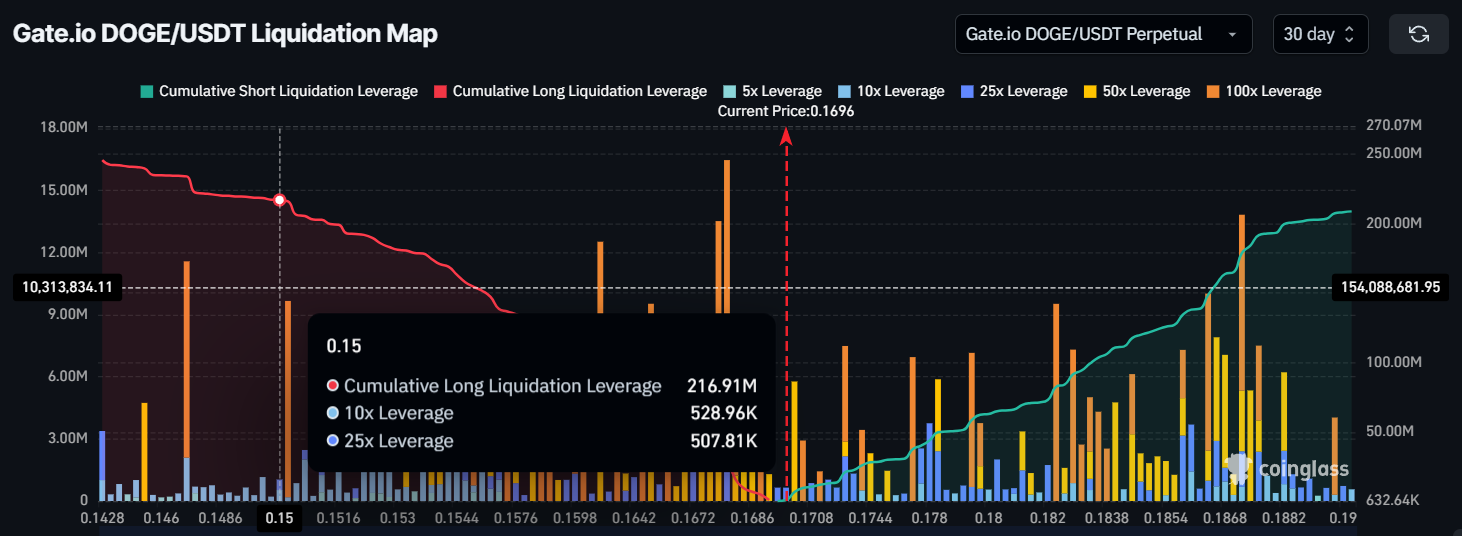
On the other hand, Dogecoin’s long-term holders (LTHs) seem to be focused on accumulating the asset at its current low price.
The HODLer net position change shows an increasing number of LTHs who are confident in eventual price recovery. As DOGE remains relatively inexpensive, these investors view the current conditions as a potential opportunity for future gains.
This accumulation by LTHs could serve as a buffer against further price declines. Their confidence in Dogecoin’s recovery and long-term potential is helping to sustain the current price levels. If these holders continue to accumulate, it could prevent a drastic drop and even pave the way for a future price rebound.
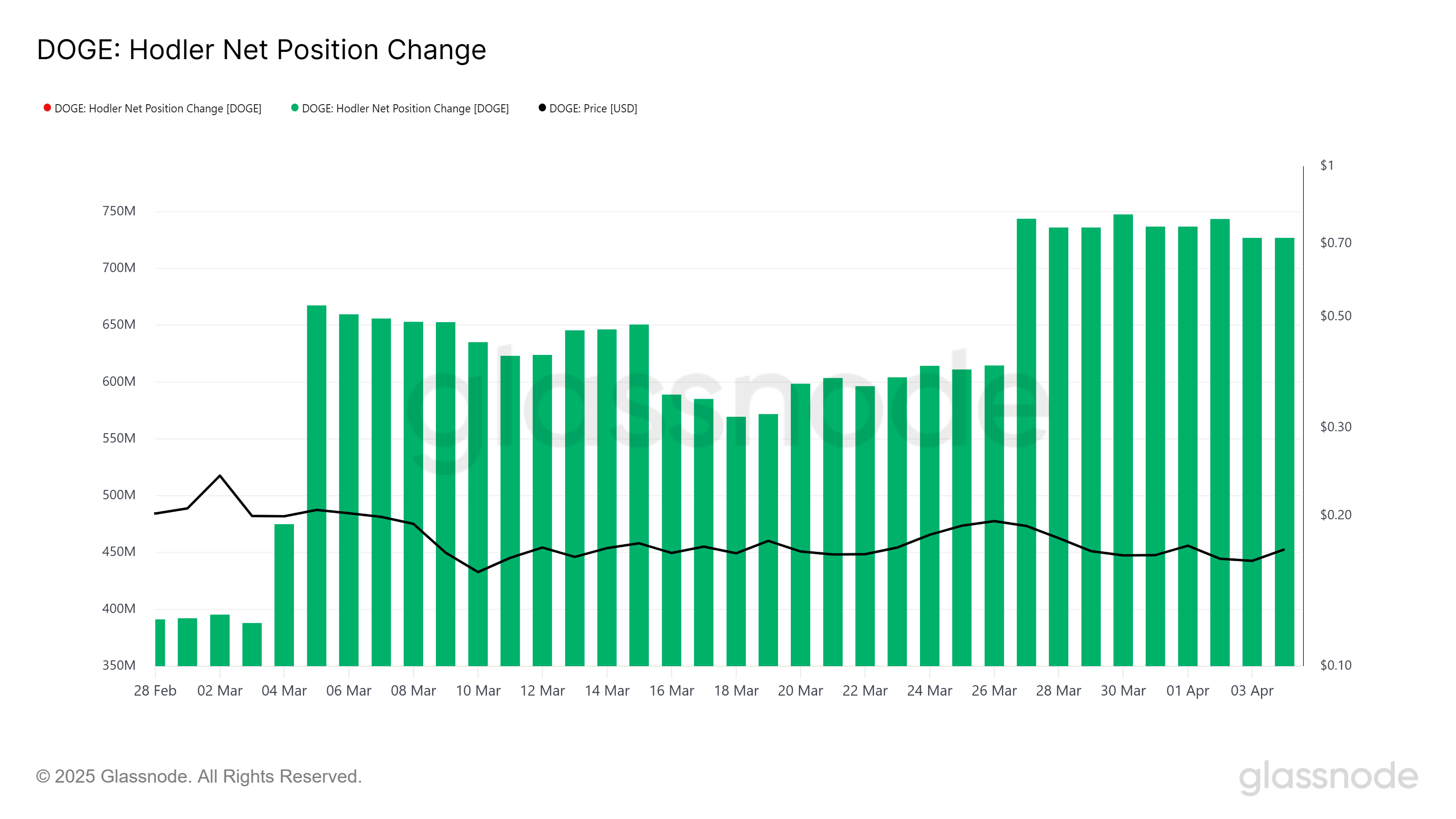
DOGE Price Correction Unlikely
At the time of writing, Dogecoin is trading at $0.169, just above the critical support of $0.164. The altcoin has been unable to break the $0.176 resistance for several days, showing signs of stagnation.
The likely outcome is continued consolidation above $0.164 as investors await a potential catalyst for upward movement.
If Dogecoin manages to breach the $0.176 resistance, it could quickly rise to $0.198, marking a positive shift in sentiment. This would likely encourage more buying activity and help push the price higher.
However, without sufficient momentum, DOGE will remain trapped within its current range, potentially facing further consolidation.

If the price falls below $0.164, it could slip to $0.147 in the coming days, triggering more than $216 million in long liquidations. This scenario would signal a shift toward bearish momentum, invalidating Dogecoin’s bullish outlook.
The coming days will be crucial in determining whether DOGE can recover or continue its decline.
Disclaimer
In line with the Trust Project guidelines, this price analysis article is for informational purposes only and should not be considered financial or investment advice. BeInCrypto is committed to accurate, unbiased reporting, but market conditions are subject to change without notice. Always conduct your own research and consult with a professional before making any financial decisions. Please note that our Terms and Conditions, Privacy Policy, and Disclaimers have been updated.
Market
SEC’s Crypto War Fades as Ripple, Coinbase Lawsuits Drop
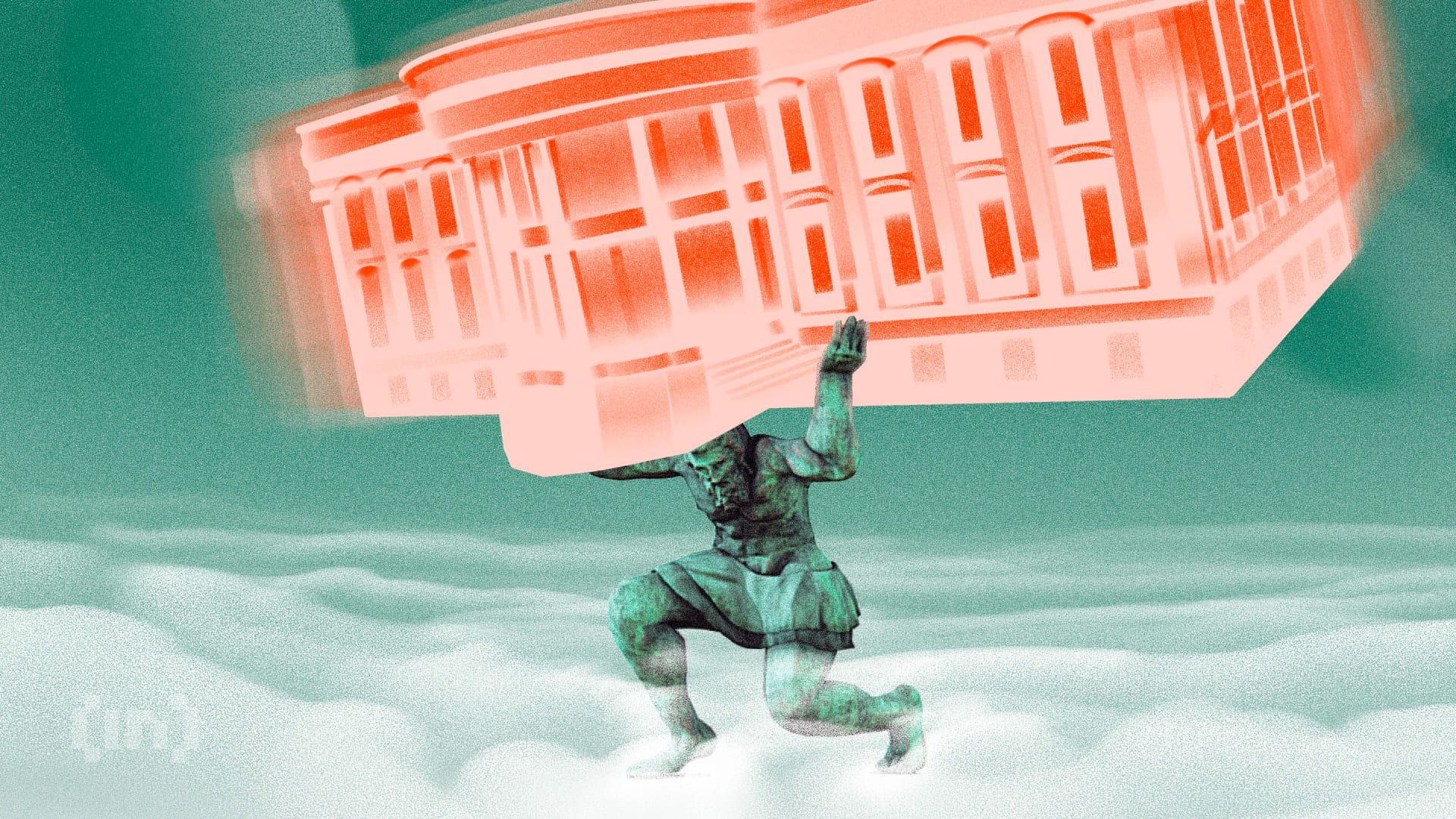
Since US President Donald Trump assumed office, the Securities and Exchange Commission (SEC) has dropped, settled, or paused lawsuits against prominent crypto entities left and right. In stark contrast to the previous administration’s leadership under Chair Gary Gensler, the SEC seems to be parting from its previous crackdown on digital assets.
In an interview with BeInCrypto, Nick Puckrin, Founder of The Coin Bureau, and Hank Huang, Chief Executive Officer at Kronos Research, highlighted the substantial election influence the crypto industry had over Trump’s candidacy as a contributing factor to the SEC’s looser stance on crypto.
The SEC’s Approach Under Trump
The SEC has experienced a clear shift in its approach to crypto lawsuits under Trump’s presidency. Its move away from the aggressive enforcement tactics of its previous leadership has largely characterized this shift.
“When President Donald Trump won the US election, the crypto industry rejoiced. Finally, the ‘regulation by enforcement’ era, which the SEC under the leadership of Gary Gensler was so famous for, was about to come to an end. And the new administration didn’t disappoint. Within just a couple of weeks of Trump’s inauguration, the revamped SEC started dropping lawsuits against crypto firms left, right and center,” Puckrin said.
Two weeks ago, the SEC officially dropped its appeal and XRP lawsuit against Ripple Labs, ending a five-year legal battle. The Commission had originally accused Ripple of conducting an unregistered securities offering worth $1.3 billion through XRP sales.
“After more than four years in limbo, the SEC has officially decided that XRP is not a security (though what it is instead remains to be seen). This case has been weighing heavily on XRP – the fourth largest cryptocurrency with a market cap of roughly $130 billion– so its resolution is a major win,” Puckrin added.
The wider crypto community celebrated the outcome, with many arguing that it will set a precedent for how digital assets are classified in the US. This prediction is warranted, given that the SEC has been on a lawsuit-dropping spree.
Ripple and Coinbase Cases Mark Significant Wins
Shortly before ending the Ripple lawsuit, the SEC dropped its legal battle against Coinbase. The case also centered on whether Coinbase should be classified as a security.
“The SEC is clearly retreating from its once-aggressive stance on crypto, as seen in its 2025 dismissal of lawsuits against Ripple, Coinbase, and others. This shift, driven by the crypto-friendly and pro-business Trump administration, signals a future of more streamlined and transparent US crypto regulation,” Huang told BeInCrypto.
The SEC has also dropped several ongoing investigations against OpenSea, Robinhood, Uniswap Labs, Kraken, and Gemini. It has also asked a federal court to issue a 60-day pause over its litigation against Binance. Meanwhile, the Commission settled its investigation into ConsenSys over its Ethereum software products.
These lawsuits surfaced in parallel to a series of crypto-friendly measures meant to foster greater innovation and curb potential regulatory suffocation that had existed during the Biden era.
Will New Leadership Define Clear Crypto Regulations?
A day after Trump assumed office, SEC Acting Chairman Mark Uyeda announced the creation of a dedicated crypto task force led by Commissioner Hester Peirce. The task force was reportedly designed to resolve long-standing ambiguities in the regulatory treatment of digital assets.
In all SEC crypto lawsuits, Commissioner Uyeda has implemented a strategy prioritizing industry engagement to develop regulatory frameworks that balance innovation and investor protection.
Meanwhile, Trump strategically nominated Paul Atkins, a crypto-curious, regulation-light candidate, to replace Gensler as head of the SEC. Just this week, the Senate Banking Committee voted to advance Atkins’ nomination to the full Senate.
“Driven by Republican principles, the SEC under Trump could implement clearer crypto guidelines by 2025, reduce regulatory burdens, and roll back Biden-era policies that have stifled innovation by 2027. This could mark the beginning of treating most digital assets as commodities,” Huang said.
Now, only a stone’s throw away from becoming SEC Chair, Atkins is expected to loosen regulatory oversight on crypto.
“With the establishment of a new Task Force and key appointees like Paul Atkins fostering innovation, Trump’s strategic move to create a Bitcoin reserve within the government further underscores his commitment to supporting the industry. The future of crypto regulations will be focused on less oversight and the beginning of a delicate but promising thaw in the regulatory landscape,” Huang added.
Though some say Trump’s handling of crypto affairs has resulted in a never-before-seen triumph, others are weary that his increasing involvement in the industry has turned out to be a recipe for disaster.
The Impact of Crypto Donations on Regulations
Several industry leaders went to great lengths to ensure that Trump became America’s 47th president. Millions of dollars in donations from crypto firms throughout Trump’s campaign illustrated these efforts.
According to a Public Citizen report, over $119 million from crypto corporations went into influencing the 2024 federal elections, largely through Fairshake, a non-partisan super PAC backing pro-crypto candidates and opposing skeptics.

Coinbase and Ripple, among others who stand to profit, directly provided over half of Fairshake’s funding. The remaining funds mostly came from billionaire crypto executives and venture capitalists. Notable contributions included $44 million from the founders of Andreessen Horowitz, $5 million from the Winklevoss twins, and $1 million from Coinbase CEO Brian Armstrong.
So far, big crypto’s spending strategy is paying off with a more favorable environment.
“Political donations from the crypto industry during the 2024 election, particularly to pro-crypto candidates like Trump, played a significant role in shaping the SEC’s 2025 decision to drop lawsuits against crypto firms. These contributions helped align the administration with the industry’s interests and influenced Congress, driving about 50-60% of the shift,” Huang told BeInCrypto.
Without a clear framework to guide the crypto industry following these dropped lawsuits, this lax approach risks being short-lived. Ultimately, this could tarnish long-term crypto adoption.
Meme Coin Scams Highlight Deregulation Dangers
According to Puckrin, the success of the dropped lawsuits was obscured by the lack of regulations that have led to the proliferation of high-profile meme coin scams.
“Somehow, all these victories feel somewhat hollow after the reputation of the crypto industry has been tarnished by the billions of dollars in combined losses from meme coin scams. Meanwhile, Hayden Davis, the mastermind behind LIBRA, continues to launch fraudulent meme tokens, despite being on the Interpol wanted list,” he said.
A 2024 report by Web3 intelligence platform Merkle Science revealed that meme coin rug pulls cost investors over $500 million. The February LIBRA incident showed how this trend was carried over to 2025. Nansen data revealed that 86% of investors lost $251 million, while insiders pocketed $180 million in profits.
Though crypto scammers may be charged with related crimes like wire fraud or money laundering, rug pulling is legal. Better said, it’s unaccounted for. No regulation holds crypto insiders responsible for meme coin scams.
“As crypto becomes an ever more mainstream asset class, consumers need to be protected against those who choose to use it for nefarious purposes. One way to do this is through education, and that’s our job as an industry. But deterring scams and extractive behavior is the job of the regulators. And it’s time they stepped up to the task,” Puckrin told BeInCrypto.
If the SEC doesn’t take advantage of this opportunity to curb the consequences that meme coin scams can produce, it will result in an enormous setback for the industry.
Comprehensive Regulation Beyond Dropped Lawsuits
Puckrin illustrated the need for heightened regulatory clarity in crypto by drawing attention to the way the SEC penalizes insider trading in the context of traditional investing.
“In traditional investing, insider trading is a serious crime. In the US, it’s punishable by fines of up to $5 million for individuals and prison sentences up to 20 years. Similarly, federal penalties for engaging with illegal gambling activities include up to five years in prison. Perpetrators of memecoin scams must be punished with the same level of severity, because the result is the same: manipulating markets and cheating unsuspecting investors out of their savings,” he said.
Puckrin clarified, however, that the issue isn’t solely about penalizing fraudsters. Just as the SEC’s past overregulation hindered the industry, the current lack of meme coin rules creates an environment where new scams and exploitative schemes can easily flourish.
“Yes, the removal of lawsuits is great news for blockchain innovation, but something needs to replace it. Indeed, serious cryptocurrency firms have never advocated for an unregulated Wild West. What they want is clarity and rules that are fit for the nascent blockchain industry – not just a copy-and-paste of existing financial regulations that simply don’t work for crypto,” he said.
Although the Trump administration has only been in place for four months, the clock is ticking, and meaningful change takes time.
Unanswered Questions Loom
Puckrin expressed concern over the current administration’s prioritization of lawsuit dismissals instead of working faster to implement transcendental crypto regulation.
“My concern is that regulators will keep kicking the can down the road with crypto regulation, having gained the approval of the industry for dropping the many lawsuits that were stifling its growth. And this is incredibly dangerous,” he told BeInCrypto.
Meanwhile, critical questions that only the SEC can define remain unanswered.
“What are memecoins and who will ensure another LIBRA fiasco doesn’t happen? Are utility altcoins now commodities and if so, will the Commodities Futures Trading Commission (CFTC) regulate them? And, importantly, what do we do about compensating investors who have lost billions to crypto fraud?” Puckrin concluded.
The SEC’s current direction promises a regulated renaissance or a breeding ground for future crises.
With billions lost and critical questions unanswered, the future of crypto hinges on whether the regulatory body will translate its recent shift into a lasting framework that fosters innovation without sacrificing investor protection.
Disclaimer
Following the Trust Project guidelines, this feature article presents opinions and perspectives from industry experts or individuals. BeInCrypto is dedicated to transparent reporting, but the views expressed in this article do not necessarily reflect those of BeInCrypto or its staff. Readers should verify information independently and consult with a professional before making decisions based on this content. Please note that our Terms and Conditions, Privacy Policy, and Disclaimers have been updated.
-

 Ethereum23 hours ago
Ethereum23 hours agoEthereum Whales Buy the Dip – Over 130K ETH Added In A Single Day
-

 Bitcoin23 hours ago
Bitcoin23 hours agoVitalik’s L2 Roadmap, XRP Unlock and More
-

 Market20 hours ago
Market20 hours agoPEPE Price Breaks Ascending Triangle To Target Another 20% Crash
-

 Altcoin19 hours ago
Altcoin19 hours agoAnalyst Predicts XRP Price To Reach Double Digits By July 21 Cycle Peak
-

 Market23 hours ago
Market23 hours agoPENDLE Token Outperforms BTC and ETH with a 10% Rally
-

 Market17 hours ago
Market17 hours agoNFT Market Falls 12% in March as Ethereum Sales Drop 59%
-
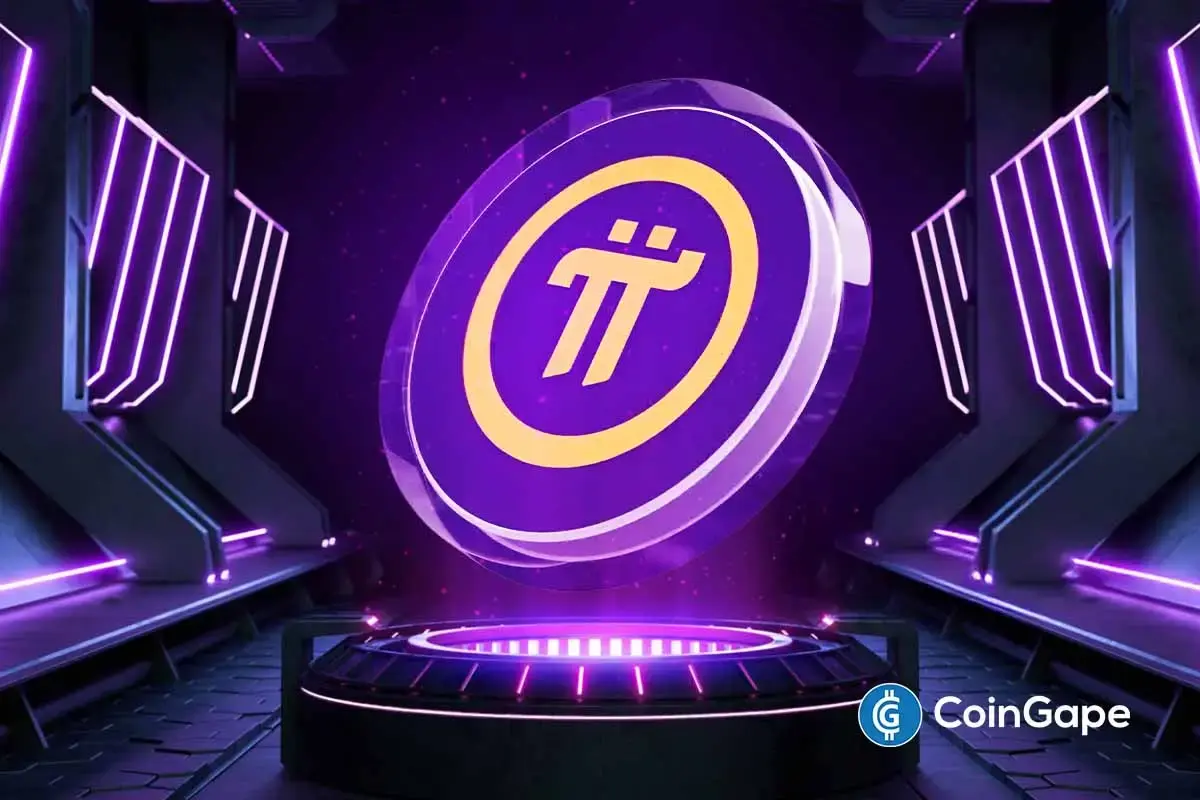
 Altcoin20 hours ago
Altcoin20 hours agoPi Network Under Fire As PiDaoSwap Launches NFTs On Binance Chain
-

 Regulation20 hours ago
Regulation20 hours agoRipple Whales Move $429 Million, What Is Going On?




